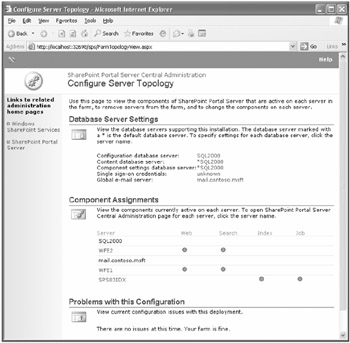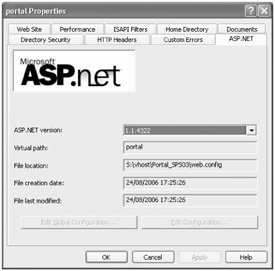Performing Pre-Upgrade Tasks
Whichever upgrade approach you decide to use, you must perform a number of pre-upgrade steps or your upgrade process might fail. When you have completed these pre-upgrade tasks, you can commence your chosen upgrade approach. The pre-upgrade tasks that were detailed in Chapter 23 should be read in conjunction with the following list of tasks:
-
Ensure your SharePoint Portal Server 2003 installation is working correctly, and in a Web farm environment, ensure that all Web servers are configured identically. This requirement also includes drive letter names. The upgrade process will notice any inconsistencies and will fail if any inconsistencies exist. Use the following tools to check your installation:
-
The SharePoint Configuration Analyzer can be used to check your SharePoint Portal Server 2003 server topology by using the SharePoint Portal Server Central Administration Web pages. Under the Server Configuration section, click Configure Server Topology. At the bottom of the Configure Server Topology Web page, check that it states, "There are no issues at this time. Your farm is fine.", as shown Figure 24-9. This does not indicate you do not have any issues, but it does state that you have a supported SharePoint Portal Server 2003 configuration.
-
The prescan.exe tool, which you will run during the upgrade process, also indicates any issues it finds in your SharePoint Server 2007 installation, but again it might not find them all.
Important Prescan.exe cannot update locked, "over quota" sites or database orphans.
-
-
Run and test a full backup of your environment.
-
Install Windows SharePoint Services 2.0 Service Pack 2 (SP2), followed by SharePoint Portal Server 2003 SP2 whose features are described at http://office.microsoft.com/en-gb/assistance/HA100806971033.aspx. Be sure also to read Microsoft Knowledge Base article KB 887623 found at http://support.microsoft.com/default.aspx/kb/887623. If you are updating a Web farm, update all Web servers to both service packs at the same time. Check that all IIS virtual servers are at the same service pack level. See Chapter 23 for details on how to check this.
-
Perform a backup of your updated environment. You cannot use the backups from step 1 to restore your environment because applying the service pack made database schema changes.
-
Install the Microsoft.Net Framework 3.0. When you do this, you will have side-by-side installations of .Net Framework 1.1 and 3.0. ASP.NET Web server extensions must be enabled in Internet Information Services (IIS). To do this, use IIS Manager or the aspnet_regiis -ir command from the .NET Framework directory (%WinDir%\Microsoft.NET\Framework\v2.0.50727).
Note Although you can leverage ASP.NET 2.0 on Windows SharePoint Services 2.0 Web applications after you have installed SP2, SharePoint Portal Server 2003 Web applications do not support ASP.NET 2.0. This does pose a quandary for you on how you intend to check that custom Web Parts you have deployed on portal Web sites work correctly in an ASP.NET 2.0 environment. We suggest that, in a test environment, you change your portal Web site to ASP.NET 2.0 using IIS Manager to view the properties of the Web site. Then on the ASP.NET tab, choose 2.0.xxxx from the ASP.NET version drop-down list, as shown in Figure 24-10. However, if you do find issues, the real test will be in a SharePoint Server 2007 environment.
-
Increase the ASP.NET runtime time out as detailed in Chapter 23, and use the IIS Manager to increase the Web sites' Connection time out on the Web Site tab to 65000 seconds.
-
Although you should have communicated and worked with site owners and users prior to this point in the process, you should once more detail the outage schedule to them.

Figure 24-9: SharePoint Portal Server 2003 server topology

Figure 24-10: Web site properties-ASP.NET tab
EAN: 2147483647
Pages: 299